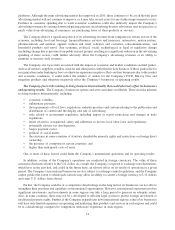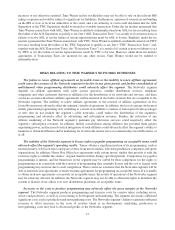Time Magazine 2010 Annual Report Download - page 30
Download and view the complete annual report
Please find page 30 of the 2010 Time Magazine annual report below. You can navigate through the pages in the report by either clicking on the pages listed below, or by using the keyword search tool below to find specific information within the annual report.The loss of subscribers could adversely affect the results of operations and future revenue growth at the
Networks segment. The Networks segment faces increased competition from services that distribute movies,
television shows and other video programming directly to consumers, including by means of online services that
offer video streaming or other means of distribution. If consumers elect to utilize these services as an alternative to
video services provided by affiliates, the networks in the segment may experience a decline in subscribers. Further,
if video services rates charged by affiliates continue to increase or economic conditions deteriorate, consumers may
cancel their video service subscriptions, reduce the number of services they subscribe to or elect to subscribe to a
lower-priced tier that may not include all of the Company’s networks. In addition, if affiliates reduce their
promotional efforts associated with the Company’s premium pay television services, the number of subscribers to
such services could decline. A decrease in the number of subscribers to the Networks segment’s networks and
services could result in a decrease in affiliate fees and advertising revenues.
RISKS RELATING TO TIME WARNER’S FILMED ENTERTAINMENT BUSINESSES
Sales of DVDs have been declining, which may adversely affect Warner Bros.’ growth prospects and results
of operations. Several factors are contributing to an industry-wide decline in DVD sales both domestically and
internationally, which has had an adverse effect on Warner Bros.’ results of operations. These factors include
challenging economic conditions, the maturation of the standard definition DVD format, piracy, intense
competition for consumer discretionary spending and leisure and entertainment time and the declining
popularity of catalog titles. Subscription rental (including subscription streaming services) and discount rental
kiosks, which generate significantly less revenue for Warner Bros. than DVD sales, have been capturing an
increasing share of consumer transactions and consumer discretionary spending, which has adversely affected DVD
prices and sales and could adversely affect Warner Bros.’ ability to increase revenues from the electronic delivery of
its films and television programming.
A decrease in demand for television programming could adversely affect Warner Bros.’ revenues. Warner
Bros. is a leading supplier of television programming. If there is a decrease in the demand for Warner Bros.’
television product, it could lead to the launch of fewer new television series and a reduction in the number of original
programs ordered by the networks, the per-episode license fees generated by Warner Bros. in the near term and the
syndication revenues generated by Warner Bros. in the future. Various factors may increase the risk of such a
decrease in demand, including station group consolidation and vertical integration of station groups and broadcast
networks, as well as the vertical integration of television production studios and broadcast networks. Vertically
integrated networks could increase the amount of programming they purchase from production companies with
which they are affiliated, driven in part by their desire to have more control over digital rights. In addition, the
failure of ratings for the programming to meet expectations and the shift of viewers and advertisers away from
network television to other entertainment and information outlets could adversely affect the amount and type (e.g.,
scripted drama) of original programming ordered by networks and the amount they are willing to pay for such
programming or could result in a network’s cancellation of a program. Local television stations may face loss of
viewership and an accompanying loss of advertising revenues as viewers move to other entertainment outlets, which
may negatively affect the segment’s ability to obtain the per-episode license fees in syndication that it has received
in the past. Finally, the increasing popularity of local television content in international regions also could result in
decreased demand, fewer available broadcast slots, and lower licensing and syndication revenues for U.S. television
content in international regions.
If the costs of producing and marketing feature films increase in the future, it may be more difficult for a film
to generate a profit. The production and marketing of feature films is very expensive and has been increasing in
recent years. The increasing popularity of 3D films and the trend toward producing event and franchise films (which
often entail higher talent costs for films later in the series) could result in even higher production costs. If production
and marketing costs continue to increase in the future, it may make it more difficult for the segment’s films to
generate a profit. Also, if film production incentives, such as subsidies and rebates, currently offered in certain
U.S. states and international territories (particularly the United Kingdom) are reduced or discontinued, Warner
Bros.’ capital requirements for production would increase.
18
























